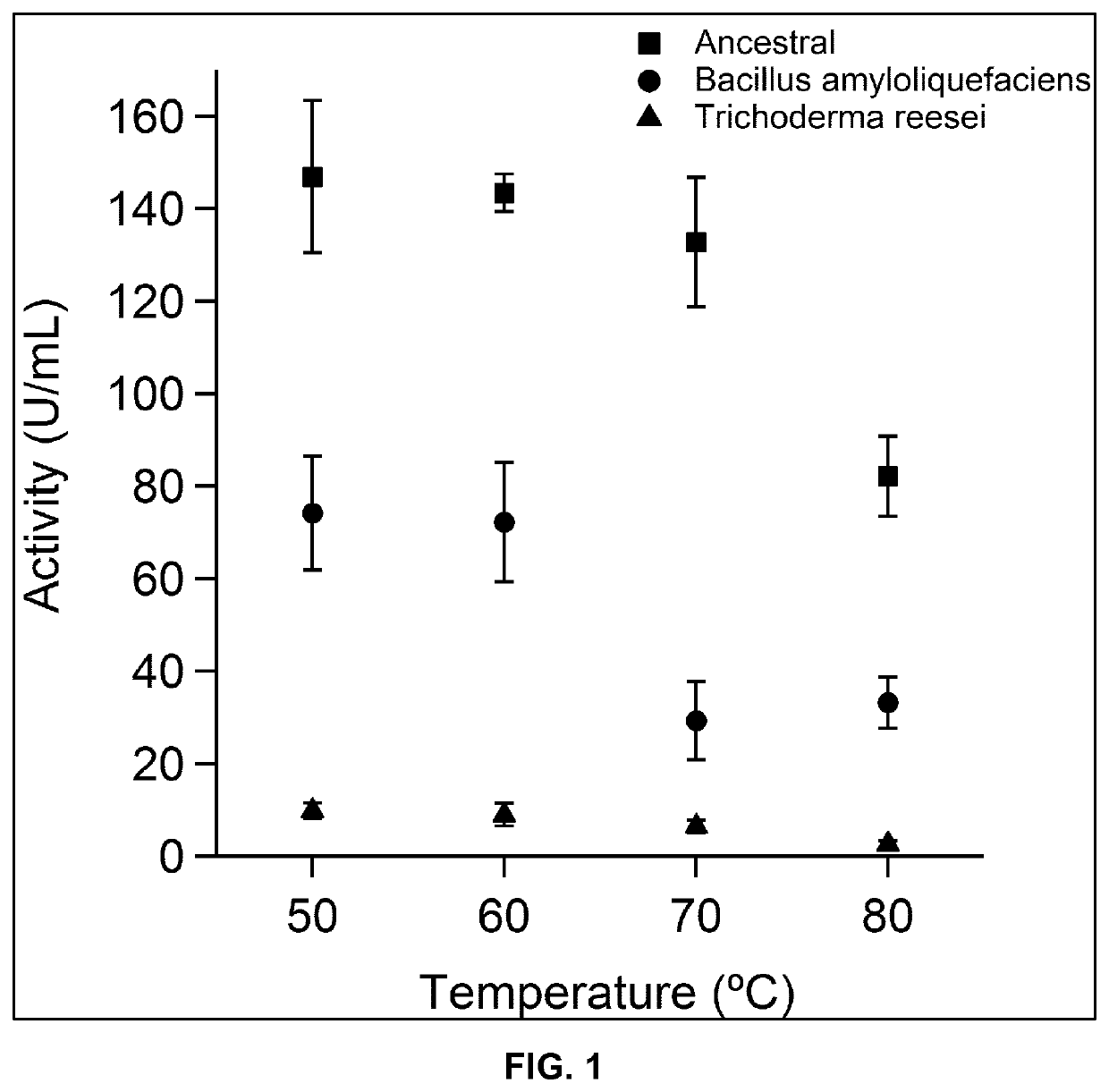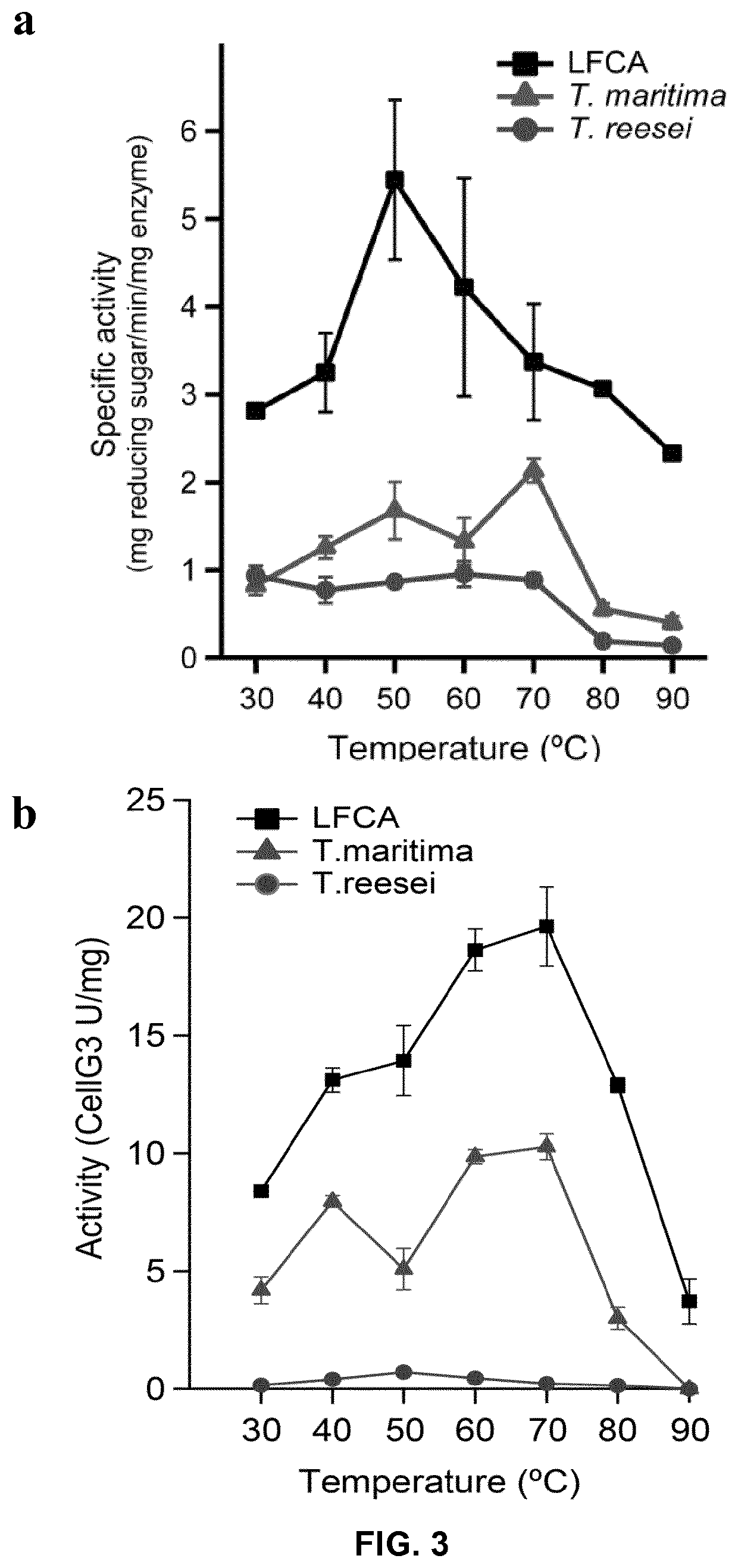Endocellulases and uses thereof
a technology of endocellulase and catalytic domain, which is applied in the field of endocellulase and its catalytic domain, can solve the problems of limited efficiency of current cellulases under industrial conditions, and achieve the effect of maintaining or improving its catalytic activity
- Summary
- Abstract
- Description
- Claims
- Application Information
AI Technical Summary
Problems solved by technology
Method used
Image
Examples
example 1
lase Activity of the Ancestral Endo-β-Ducanase
[0206]The endocellulase activity was assayed using three endocellulases, namely the polypeptide of SEQ ID NO:2 and two commercial cellulases for comparison. The commercial cellulases correspond to the bacterial endocellulase from B. amyloliquefaciens and the fungal endocellulase from Trichoderma reesei. For all three enzymes five independent assays were performed obtaining an average value and standard deviation. In all cases the inventors used an equal concentration of enzyme in the original solution. The test was performed at increasing temperatures. As it can observed in FIG. 1, the ancestral cellulases display a considerably higher activity measured in CellG3 units. In the case of T. reesei, the activity is notably lower than the activity of bacterial endocellulases. At temperature above 70° C. the activity of T. reesei endocellulase is barely measurable. In the case of the bacterial ones, it is obvious that the enzyme of SEQ ID NO: ...
example 2
bility of the Ancestral Endo-β-Ducanase
[0208]To test the thermal ability of endocellulase (SEQ ID NO:69), specific activity assays were performed at temperatures ranging from 30 to 90° C., and compared them with the activity of modern day enzymes at equal temperatures. We used soluble carboxymethil cellulose (CMC) as substrate. The activity was determined spectrophometrycally as the amount in mg of reducing sugar released per minute and per mg of enzyme used (see Material and Methods). The ancestral endocellulase outperformed the activity of T. maritima and T. reesei cellulases by a large margin, showing elevated activity at 90° C. (FIG. 3a). This is an extremely high temperature for an endocellulase only achieved by archaeal cellulases. Although the maximum activity is displayed at 50° C., this seems to be related to the substrate used, CMC. Experiments using and endocellulase specific substrate such as CellG3, report a different temperature profile with maximum activity at 70° C. ...
example 3
ity of the Ancestral Endo-β-Glucanase
[0209]In addition, pretreatment of lignocellulosic material can be carried out at low or high pH values. Therefore, improving the pH dependence of cellulase activity is also of interest from an industrial point of view. We tested the pH dependence of cellulase activity in the range 4-12 at a temperature of 70° C. for the endocellulase (SEQ ID NO:69). We used the same substrate CMC and determined specific activity. Again, the ancestral cellulase outperformed the activity of the modern enzymes from T. maritima and T. reesei, showing a highly increased activity in the entire pH range but especially in the range 6-12 (FIG. 4). The activity in this range is about 5-fold that of T. reesei endoglucanase and over 3-fold that of T. maritima. We also acquired experiments combining different temperature and pH ranges (FIG. 5).
PUM
| Property | Measurement | Unit |
|---|---|---|
| temperatures | aaaaa | aaaaa |
| pH | aaaaa | aaaaa |
| temperature | aaaaa | aaaaa |
Abstract
Description
Claims
Application Information
 Login to View More
Login to View More - R&D
- Intellectual Property
- Life Sciences
- Materials
- Tech Scout
- Unparalleled Data Quality
- Higher Quality Content
- 60% Fewer Hallucinations
Browse by: Latest US Patents, China's latest patents, Technical Efficacy Thesaurus, Application Domain, Technology Topic, Popular Technical Reports.
© 2025 PatSnap. All rights reserved.Legal|Privacy policy|Modern Slavery Act Transparency Statement|Sitemap|About US| Contact US: help@patsnap.com



